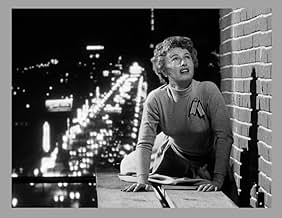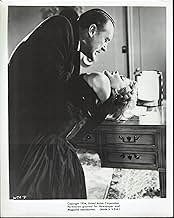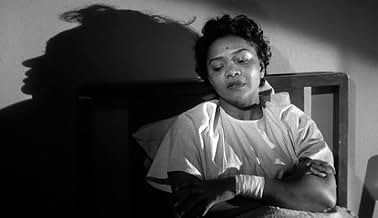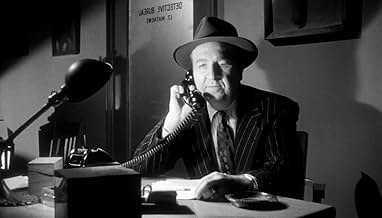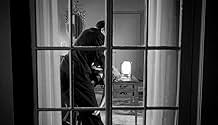AVALIAÇÃO DA IMDb
6,6/10
3,7 mil
SUA AVALIAÇÃO
Adicionar um enredo no seu idiomaA woman's sanity comes into question, after she claims to have witnessed a murder from her apartment window.A woman's sanity comes into question, after she claims to have witnessed a murder from her apartment window.A woman's sanity comes into question, after she claims to have witnessed a murder from her apartment window.
- Direção
- Roteiristas
- Artistas
Adeline De Walt Reynolds
- The Old Lady
- (as Adeline de Walt Reynolds)
Claude Akins
- Police Officer
- (não creditado)
Ralph Brooks
- Man at Lunch Counter
- (não creditado)
Russell Custer
- Police Officer
- (não creditado)
Sam Edwards
- Tommy
- (não creditado)
Jean Fenwick
- Nurse
- (não creditado)
Fred Graham
- Plainclothes Man
- (não creditado)
- Direção
- Roteiristas
- Elenco e equipe completos
- Produção, bilheteria e muito mais no IMDbPro
Avaliações em destaque
Witness to Murder (1954)
** 1/2 (out of 4)
Great performances are somewhat wasted in this thriller that simply has way too many logical problems to really work. Cheryl (Barbara Stanwyck) wakes up one night and looks across the street to an open window where she sees a man (George Sanders) kill a woman. Cheryl goes to the police but they don't believe her and after a while they start to think she's the one that is crazy. She strikes up a relationship with the lead detective (Gary Merrill) but the only person who knows she's telling the truth is the killer himself. WITNESS TO MURDER features three great performances from the leads but sadly there are just way too many logic issues that keep this from being a complete winner. As many other reviewers have pointed out, there were times where I wanted to jump through the screen and just smack the detective and those helping on this case. It doesn't help that right from the start no one is taking the woman serious because if anyone had done the smallest amount of work then there were all sorts of signs that she was telling the truth. Another big problem is that the Sanders character can pretty much do whatever he wants, no matter how silly it is, and the police will never question it. After a while you pretty much just have to throw your hands in the air. Another major problem I had was with the music score, which was just constantly on and being way too dramatic for its own good. With that said, the three leads really make the film worth watching and especially Sanders who is terrific as the villain. He does a great job at playing this rather dark character and I loved the way the actor played it up to scare Stanwyck while playing it cool and collective whenever facing the police. Director Roy Rowland does a nice job with the ending, which contains some suspense but sadly the screenplay doesn't give him more to work with.
** 1/2 (out of 4)
Great performances are somewhat wasted in this thriller that simply has way too many logical problems to really work. Cheryl (Barbara Stanwyck) wakes up one night and looks across the street to an open window where she sees a man (George Sanders) kill a woman. Cheryl goes to the police but they don't believe her and after a while they start to think she's the one that is crazy. She strikes up a relationship with the lead detective (Gary Merrill) but the only person who knows she's telling the truth is the killer himself. WITNESS TO MURDER features three great performances from the leads but sadly there are just way too many logic issues that keep this from being a complete winner. As many other reviewers have pointed out, there were times where I wanted to jump through the screen and just smack the detective and those helping on this case. It doesn't help that right from the start no one is taking the woman serious because if anyone had done the smallest amount of work then there were all sorts of signs that she was telling the truth. Another big problem is that the Sanders character can pretty much do whatever he wants, no matter how silly it is, and the police will never question it. After a while you pretty much just have to throw your hands in the air. Another major problem I had was with the music score, which was just constantly on and being way too dramatic for its own good. With that said, the three leads really make the film worth watching and especially Sanders who is terrific as the villain. He does a great job at playing this rather dark character and I loved the way the actor played it up to scare Stanwyck while playing it cool and collective whenever facing the police. Director Roy Rowland does a nice job with the ending, which contains some suspense but sadly the screenplay doesn't give him more to work with.
In addition to its solid performances, tight storytelling and John Alton's superior cinematography, what makes "Witness to Murder" particularly powerful today is the movie's pre-feminist view of its leading character's dilemma. "But I saw the murder, I SAW the murder," the Stanwyck character insists. Yet no one believes her because 1) she's a woman; 2) she's unmarried; 3) she's menopausal. Nobody even blinks an eye when she's dumped in a mental hospital, which gets viewers really riled because they share her point of view. The audience sees the murder along with Stanwyck and can feel her humiliation, anger and frustration. That's why the movie works.
Perhaps Barbara Stanwyck was looking to score another Oscar with Witness To
Murder. Her fourth and final nomination was with Sorry Wrong Number. In
that film she overhears a murder plot.
In this one she sees neighbor George Sanders commit a strangulation on some woman. But the police show up and no body and no signs of struggle. Still Stanwyck persists and detectives Gary Merrill and Jesse White do their best..
We learn too early that Sanders did the deed which robs us of suspense. Still Sanders is at his caddiest and that's always a treat.
The best scenes are Stanwyck in a mental ward and she's in with a lot of those you would have seen in the Snake Pit. Wonderful scene allowing all the players including Stanwyck to overact and stay in character.
Timing is everything and Witness To Murder was released first so it was no copycat. But Alfred Hitchcock's Rear Window with the same premise and all those Hitch touches came out far superior and this film was forgotten.
Stanwyck and the cast do a good job though and Witness To Murder should not be forgotten.
In this one she sees neighbor George Sanders commit a strangulation on some woman. But the police show up and no body and no signs of struggle. Still Stanwyck persists and detectives Gary Merrill and Jesse White do their best..
We learn too early that Sanders did the deed which robs us of suspense. Still Sanders is at his caddiest and that's always a treat.
The best scenes are Stanwyck in a mental ward and she's in with a lot of those you would have seen in the Snake Pit. Wonderful scene allowing all the players including Stanwyck to overact and stay in character.
Timing is everything and Witness To Murder was released first so it was no copycat. But Alfred Hitchcock's Rear Window with the same premise and all those Hitch touches came out far superior and this film was forgotten.
Stanwyck and the cast do a good job though and Witness To Murder should not be forgotten.
I have been a fan of Stanwycks since I was a child (now 55 yrs)..saw and thought I knew most of her films from mid 30's- on to the TV years. Somehow, Witness To Murder escaped me, until I saw it listed to be shown on TCM (thank you Ted), this weekend 11/23, I believe... I set my vcr, and was not disappointed, what an outstanding film noir this is.. yet no one ever mentions or discusses this one !!!Stanwyck is just as good as she was in Sorry Wrong Number, maybe more controlled... Plot is similar to Hitcocks Rear Window, but it has many more twists and turns. Supporting cast is great, including 2 All About Eve alumni.. George Sanders, playing a sadistic Nazi (yes) murderer his best work since Eve, and Gary Merrill, portraying a police detective...You can see future star and Oscar nominee, Juanita Moore, (Imitation of Life '58) in an assylum scene, very effective, and Jesse White, as Merrills partner giving some comic relief... Wow, couldnt stop watching... Great to see this ignored film from mid 1950's. Is it on tape ?? Aside #1: Gary Merrill was married to Bette Davis at the time... She and Stanwyck did not get along...I would have loved to be a fly on the wall when Gary came home from work... during the filming of Witness.
Aside# 2: Stanwyck was the most prolific actress in Hollywood history!! She just kept turning them out. I remember my parents taking us to our local theatre, Regent, in Newark, NJ.. and every other week so it seemed was a Stanwyck movie... We had just seen her in Titanic, and soon she would be in Executive Suite.... what a pro, what a career, what an actress... she was such a family favorite that my older sister was named after her, Barbara......
Aside# 2: Stanwyck was the most prolific actress in Hollywood history!! She just kept turning them out. I remember my parents taking us to our local theatre, Regent, in Newark, NJ.. and every other week so it seemed was a Stanwyck movie... We had just seen her in Titanic, and soon she would be in Executive Suite.... what a pro, what a career, what an actress... she was such a family favorite that my older sister was named after her, Barbara......
This is the kind of cat and mouse thriller that we will never make again. It is a movie that went through a process. Someone had an idea, wrote the story, set the atmosphere, and produced a white knuckled mystery. Boy, do I miss film noir.
Barbara Stanwyck plays an intelligent professional woman who sees a woman murdered in the apartment across from her. She calls the police who come to the conclusion she was dreaming. Gary Merrill plays the weary, but sympathetic, detective who investigates. They question the suspect - George Sanders - but he eventually convinces them that she is unbalanced. She becomes more and more desperate for someone to believe her all the while she is being set up. She and Gary Merrill begin to fall in love. He wants to believe her, but George has spun an insidious web. Eventually she finds herself under suspicion and is sent to the cuckoo's nest for observation. There is bizarre confrontation between Barbara and George where he actually admits the murder and proclaims himself the savior of the 4th Reich! You'll have to take it from there.
Barbara Stanwyck was a little past her prime, but she still put out the passion and energy that made her famous. George Sanders really looked tired, but displayed that old world charm that makes little old ladies melt. Gary Merrill is such a likable guy, you tend to forget that he can't act.
There was not one car chase, not one explosion, and no one fired a pistol, never mind a Mach 10. Boy I miss these movies.
Barbara Stanwyck plays an intelligent professional woman who sees a woman murdered in the apartment across from her. She calls the police who come to the conclusion she was dreaming. Gary Merrill plays the weary, but sympathetic, detective who investigates. They question the suspect - George Sanders - but he eventually convinces them that she is unbalanced. She becomes more and more desperate for someone to believe her all the while she is being set up. She and Gary Merrill begin to fall in love. He wants to believe her, but George has spun an insidious web. Eventually she finds herself under suspicion and is sent to the cuckoo's nest for observation. There is bizarre confrontation between Barbara and George where he actually admits the murder and proclaims himself the savior of the 4th Reich! You'll have to take it from there.
Barbara Stanwyck was a little past her prime, but she still put out the passion and energy that made her famous. George Sanders really looked tired, but displayed that old world charm that makes little old ladies melt. Gary Merrill is such a likable guy, you tend to forget that he can't act.
There was not one car chase, not one explosion, and no one fired a pistol, never mind a Mach 10. Boy I miss these movies.
Você sabia?
- CuriosidadesIn an unusual connection for the time (or possibly a product placement), the W&J Sloan Company in Beverly Hills - where Cheryl worked - was a real furniture and interior decorating firm founded in New York City in 1843. It went bankrupt in 1985. According to the end credits, the company supplied set decorations and furnishings for the film.
- Erros de gravaçãoThe story is taking place in Los Angeles, but the map on the wall in Larry's office is that of San Francisco.
- Citações
[repeated line]
The Old Lady - Mental Patient: Show Mr. Peabody into the library please.
- ConexõesFeatured in Frances Farmer Presents: Witness to Murder (1959)
Principais escolhas
Faça login para avaliar e ver a lista de recomendações personalizadas
Detalhes
- Data de lançamento
- País de origem
- Idiomas
- Também conhecido como
- Testigo del crimen
- Locações de filme
- Linda Vista Apartments, 939 S. Serrano Ave., Los Angeles, Califórnia, EUA(Cheryl Draper's apartment building)
- Empresa de produção
- Consulte mais créditos da empresa na IMDbPro
- Tempo de duração1 hora 23 minutos
- Cor
- Proporção
- 1.75 : 1
Contribua para esta página
Sugerir uma alteração ou adicionar conteúdo ausente

Principal brecha
By what name was Testemunha do Crime (1954) officially released in India in English?
Responda
![Assistir a Trailer [EN]](https://m.media-amazon.com/images/M/MV5BYjI4NDBiYmQtN2U0MS00MTdjLWI0YzEtODBkYjE0YjQ1MDc4XkEyXkFqcGdeQXRyYW5zY29kZS13b3JrZmxvdw@@._V1_QL75_UX500_CR0)
